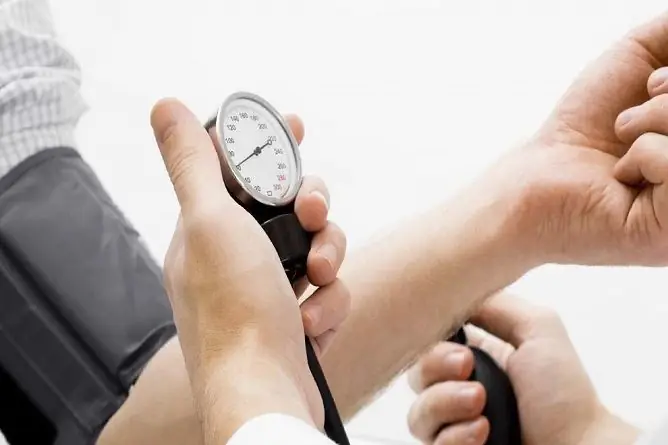- Author Rachel Wainwright [email protected].
- Public 2023-12-15 07:39.
- Last modified 2025-11-02 20:14.
Human blood pressure
The content of the article:
- Blood pressure and mechanisms of its maintenance
- How to measure pressure
- Normal blood pressure
-
Blood pressure pathologies
- Hypertension
- Hypotension
- How to normalize blood pressure
- Video
Blood pressure (BP) is one of the most important parameters in the human body, to maintain a stable level of which many mechanisms of adaptation of internal and external factors work. This parameter can vary depending on the state in which the organism is, the functional ability of all necessary organs and systems, environmental factors that do not affect it. Every second person faces an obvious problem - instability of blood pressure, which leads to poor health, diseases, long-term treatment of complications and decreased performance.

It is recommended to measure your blood pressure when you feel well in order to know the individual rate
Blood pressure and mechanisms of its maintenance
The blood pressure indicator is an absolute value that reflects the hydrodynamic (blood is a liquid and is in constant motion) blood pressure on the vascular wall.
The pressure of the systemic blood flow affects differently vessels of different calibers, arteries, veins, capillaries - due to differences in their structure, as well as the difference in diameters. Based on a number of physical laws, it weakens, until the blood reaches the branched capillary network, the blood flow rate is significantly reduced. This mechanism is also embedded in the functioning of different parts of the cardiovascular system: the heart acts as a pump, the pressure in its chambers is maximum. Then in the main vessels (arteries) it is still high enough to continue the pulse wave impulse. In cavity vessels like veins, the pressure is small, since the primary impulse from the heart has been exhausted, the muscle elements of the venous wall, contracting, move blood to the heart themselves. In the capillaries, blood pressure and velocity are balanced so thatto efficiently metabolize nutrients, metabolites and oxygen from the lumen of the vessel to the cell space and back.
The universal parameter of human blood pressure is considered to be the pressure in the aorta - the largest vessel in the human body, located immediately after the heart on the blood path. However, with minimal changes, it remains approximately the same in other large arteries, due to the special elasticity of their walls. Therefore, blood pressure can be measured at the ulnar artery - this is the method that is used everywhere.
Since pressure mainly depends on two main components - the force of cardiac output and vascular resistance, a distinction is made between systolic and diastolic blood pressure.

Blood pressure is made up of two indicators - systolic, or upper, and diastolic, or lower
What is systolic or upper pressure? This is an indicator that determines the strength and heart rate and is characterized by the intensity of the heart muscle, as well as the volume of ejection for each beat. If pathological changes are observed from the side of this indicator (the larger number of two), then the heart is usually the source of the problem.
Diastolic, or lower pressure, depends on the peripheral resistance of the vessels and is regulated by the tone of the nervous system and a complex system of humoral, i.e., organized through biologically active fluids, connections. The level of pressure also depends on the kidneys as the main filter of the body, on the renin they produce, which turns into the most powerful vasoconstrictor amine - angiotensin, and on several other hormones of the adrenal glands and the pituitary gland. Thus, if there is a pathological decrease or increase in lower pressure, first of all, attention should be paid to the endocrine glands and kidneys.
If the difference between the upper and lower pressures is excessively large, isolated aortic hypertension may be suspected. This condition is typical for patients with atherosclerosis of the aorta and great vessels, because, having lost their elasticity, they cannot compensate for the cardiac impulse. If the difference between systolic and diastolic pressure is too small, then this indicates a disturbance in the work of the cardiovascular system both from the heart and from the vessels. More often this is caused by the classic lowering of blood pressure due to heart failure.
Circulating blood volume (BCC) plays an important role in blood pressure control. It decreases if an insufficient amount of fluid enters the body or its loss increases - in the hot season, during sports or strenuous physical labor. Fluid quickly leaves the body in diabetes mellitus, since glucose is an osmotically active substance that retains water.
How to measure pressure
To know your body well and understand the signals that it gives, you should develop the habit of regularly measuring blood pressure. Knowing the individual norm will help to monitor the state of the body, because the book indicators are averaged and do not always reflect the state of an individual.
There are several methods for measuring pressure, they are divided into direct and indirect. The first category means that the measurement takes place directly in the vascular bed. This method is rarely used, more often in experiments or during complex operations, but it is the most reliable and provides the most accurate indicators. For this, a needle from a device is inserted into the lumen of the vessel, which measures the pressure difference after each impact. It is also possible to implant special miniature sensors for a long time, this practice is increasingly being used in Europe and America.
The indirect method is less accurate but much easier to use. This is a well-known technique - measuring pressure by the Korotkov method. There are many automatic and semi-automatic blood pressure monitors, but the essence is the same - the pressure in the cuff is pumped until special pulsating sounds - Korotkoff's tones - are no longer heard, the indicator on the tonometer, when they become audible, reflects the systolic pressure. The pressure in the cuff continues to decrease until the tones disappear - at this border the diastolic pressure is recorded. To measure with a classic tonometer, you need a stethoscope, which is placed under the cuff and allows you to listen to individual tones.

The classical method for measuring blood pressure is a Korotkov tonometer
How is pressure measured? To designate its quantitative indicator, millimeters of mercury or water column are used, while the most common and convenient version of mercury, therefore, the value is designated as mm Hg. Art.
There are several rules for measuring pressure that cannot be neglected in order to get the most accurate result:
- Place the cuff not on clothing, but only directly on the skin.
- The cuff is installed above the elbow, conventionally at the same level with the heart.
- The air supply tube should be parallel to the limb and ulnar artery.
- The pressure in the cuff is built up until the Korotkov tones appear, after which it is pumped up even more until they disappear, only then it starts to decrease.
To obtain the most accurate value, the following method is used in medical practice: the pressure is measured on two hands three times, and then the largest indicator obtained is selected. Only after this, it is possible to conclude about an increase or decrease in blood pressure, although a one-time measurement is allowed for preventive purposes and at home.
Normal blood pressure
Indicators of the norm are individual, they are defined as a range of permissible values, while the norm differs slightly by age and category. A universal way to find out the optimal pressure for a particular age is to calculate using special formulas that allow you to get numbers as close as possible to real ones:
- systolic pressure = 109 + (0.5 x age) + (0.1 x weight);
- diastolic pressure = 63 + (0.1 x age) + (0.15 x weight).
There are also tables that show pressure standards for a specific age. For example, in children under 3 years old, this is on average 100 to 60 mm Hg. Art., at 14 years old, the upper limit reaches 110-115 at 70 mm Hg. Art., at 16 years of age or more is compared with an adult indicator of the norm, that is, 129 to 79 mm Hg. Art. In adults, pressures in the range of 120-139 for systolic and 79-89 for diastolic are considered prehypertension and require special attention from both the patient and the medical staff. In older people, the numbers of systolic pressure often increase with a stable diastolic pressure, since the tone and elasticity of large coronary vessels decreases. This is a risk factor for cardiovascular disease.

Table of normal blood pressure indicators depending on age
Blood pressure pathologies
The two main pathologies associated with changes in blood pressure levels are an increase (hypertension) and a decrease (hypotension), which are outside the normal range. Both conditions, in the absence of treatment, can lead to unwanted complications, up to and including lethal.
It should be borne in mind that the subjective symptoms of pressure, both high and low, cannot be a reason for its drug correction. The feasibility of using drugs is determined only by the results of its measurement.
Hypertension
Elevated blood pressure is characterized by headache, pulsation in the temples, flies before the eyes, chest pain, sometimes shortness of breath, tinnitus, dizziness, weakness, and a feeling of internal squeezing.
The pressure can be constantly increased or increase sporadically, depending on the influence of a certain external or internal factor, for example, in hot weather or during hard physical labor.
An extreme form of increased blood pressure is a hypertensive crisis, a condition in which the pressure of blood on the walls of blood vessels is such that it can cause them to deform, spasm, or rupture. The target organs are the first to suffer - the brain, heart, kidneys, liver, lungs, that is, those organs that require increased blood supply. A hypertensive crisis, especially when it manifests itself for the first time, requires urgent medical attention, and often hospitalization.
The reason for the increase in blood pressure is an imbalance between cardiac output and peripheral resistance, which is caused by risk factors - atherosclerotic changes in the walls of blood vessels, chronic diseases of the cardiovascular system, diabetes mellitus, bad habits (smoking and alcohol abuse), a sedentary lifestyle, constant sleep disturbance and wakefulness, an unbalanced diet.
Hypotension
A decrease in pressure, in turn, can develop after bleeding, with a sharp movement after a long stay in a supine position, with infectious diseases, allergic reactions, heart failure. In women, a slightly reduced pressure is physiological due to the presence of estrogens - sex hormones that reduce it, the increased production of these hormones occurs in the first trimester of pregnancy, and therefore pregnant women often suffer from hypotension.
Signs of low blood pressure: drowsiness, muscle weakness, numbness in the extremities, dizziness, tachycardia, arrhythmia, a feeling of heartbeat stronger than usual, weak pulse. The consequence of hypotension can be vascular collapse. What does collapse mean? This is a condition in which the most vulnerable organs, primarily the brain, suffer from insufficient blood circulation. Oxygen starvation of the brain leads to loss of consciousness. The collapse develops at a pressure of 80 to 60 mm Hg. Art. and below, which is critical.
How to normalize blood pressure
What if the patient experiences discomfort indicating excessively low or high blood pressure? First of all, you need to calm down and measure the pressure - find out exactly whether it is increased or decreased. This is due to the fact that hypo- and hypertension often have similar manifestations. Do not take pressure pills as soon as discomfort appears. If possible, it is necessary to consult a doctor, ask about the most suitable means of dealing with pressure pathologies for this particular case.
With high blood pressure, first aid can be used - sedatives, sedatives like valerian or mint tea with lemon or viburnum. If the pressure is lowered, you can drink strong tea or coffee, in rare cases and in the absence of contraindications, it is permissible to use an energy drink. Only after that, if the simplest methods did not help, you can resort to pharmacological drugs to reduce or increase pressure, but the doctor must choose them.

Before taking pills for hypo- or hypertension, it is imperative to measure the pressure
If you cannot normalize the pressure on your own, and the situation gets out of control, you should immediately call an ambulance.
Video
We offer for viewing a video on the topic of the article.

Nikita Gaidukov About the author
Education: 4th year student of the Faculty of Medicine No. 1, specializing in General Medicine, Vinnitsa National Medical University. N. I. Pirogov.
Work experience: Nurse of the cardiology department of the Tyachiv Regional Hospital No. 1, geneticist / molecular biologist in the Polymerase Chain Reaction Laboratory at VNMU named after N. I. Pirogov.
Found a mistake in the text? Select it and press Ctrl + Enter.






